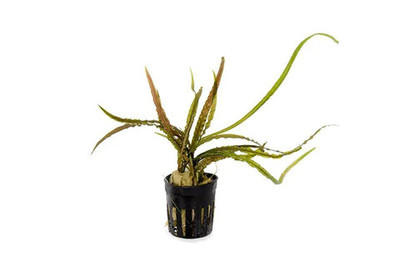Cryptocoryne Retrospiralis
Posted by Max Gandara on on 11th Oct 2024
Cryptocoryne retrospiralis is a species of aquatic plant belonging to the family Araceae. This plant is favored by aquarists for its ability to thrive in a variety of aquarium conditions and for its striking appearance, which adds texture and color to aquascapes. It is native to India and can be found in slow-moving rivers and streams where the water is often slightly acidic to neutral. Its long, spiral-like leaves and easygoing nature make it a great option for beginners and seasoned aquarium enthusiasts alike.
Physical Appearance
Cryptocoryne retrospiralis is known for its distinctive long, narrow leaves that can reach 12 to 20 inches (30 to 50 cm) in length. The leaves are typically green to olive-brown in color with a subtle reddish hue, giving the plant a unique and natural look. One of the defining features of this species is the spiral or twisted nature of its leaves, which creates an appealing, flowing effect in aquascapes. The plant grows from a thick rhizome, which helps anchor it into the substrate.
Natural Habitat and Origins
Cryptocoryne retrospiralis is native to India, where it grows in the slow-moving, shallow waters of rivers, streams, and marshes. In the wild, it often experiences periods of both submerged and emersed growth, meaning it is capable of adapting to varying water levels and conditions. This versatility allows it to thrive in a wide range of aquarium setups.
The natural habitat of Cryptocoryne retrospiralis typically has:
- Soft, slightly acidic to neutral water with a pH range of 6.0 to 7.5
- Temperatures between 68°F and 82°F (20°C to 28°C)
- Low to moderate light conditions, as the plant is often found in shaded areas
Caring for Cryptocoryne Retrospiralis in Aquariums
Cryptocoryne retrospiralis is a hardy plant that adapts well to a variety of aquarium environments. It's an excellent choice for beginners due to its resilience and relatively low maintenance requirements.
Tank Requirements:
- Lighting: Cryptocoryne retrospiralis can tolerate a wide range of lighting conditions, from low to medium-high. However, it typically grows best in moderate lighting. Low light will result in slower growth but can still support healthy development.
- Substrate: This plant prefers a nutrient-rich substrate, as it feeds primarily through its roots. Using a substrate enriched with iron or fertilizer tablets can help promote lush growth. Sand or fine gravel also works well to anchor its rhizomes.
- Water Parameters: It thrives in soft to moderately hard water, with a pH range of 6.0 to 7.5 and temperatures between 68°F and 82°F (20°C to 28°C). Regular water changes help maintain water quality, but Cryptocoryne retrospiralis can tolerate fluctuating conditions, making it a versatile option for most tanks.
Growth Pattern: Cryptocoryne retrospiralis is a slow-growing plant that forms a rosette of long, ribbon-like leaves. Over time, the plant will spread by sending out runners, forming a dense, attractive cluster in the aquarium. Patience is key when growing this plant, as it may take several weeks to acclimate to a new environment and start showing signs of growth.
One notable aspect of Cryptocoryne species is their susceptibility to "Crypt Melt," a condition where the plant’s leaves melt and decay when first introduced to a new environment or when there is a significant change in water conditions. However, this is usually temporary, and the plant will recover by growing new leaves adapted to the aquarium conditions.
Aquascaping Uses
Cryptocoryne retrospiralis is an excellent plant for mid-ground to background placement in aquariums due to its tall, narrow leaves. Its flowing, spiral-like appearance adds vertical interest to aquascapes, creating a natural, jungle-like aesthetic. It pairs beautifully with other plants, such as Anubias, Java Fern, and Vallisneria, to create a layered, textured look.
Its relatively slow growth makes it easy to maintain, as it doesn't require frequent trimming. The plant’s height makes it ideal for larger tanks where it can fill vertical space without overwhelming the aquascape.
Propagation
Propagation of Cryptocoryne retrospiralis is straightforward. The plant reproduces through runners, which are horizontal stems that grow along the substrate and develop new plants. Once the runners form, small plantlets will emerge at intervals along the stem. These plantlets can be separated from the parent plant and replanted in other parts of the aquarium or left to form a dense cluster.
For successful propagation:
- Ensure the substrate is nutrient-rich to encourage healthy root development.
- Leave enough space between plants to allow the runners to spread naturally.
- Use root tabs or other fertilizers to provide essential nutrients if your substrate is nutrient-poor.
Compatibility with Other Aquarium Plants and Fish
Cryptocoryne retrospiralis is a peaceful plant that does well with a wide variety of fish and other aquatic plants. Its sturdy leaves are rarely nibbled on by fish, making it suitable for tanks with herbivorous fish. It can also withstand the digging habits of species like Corydoras Catfish and loaches, as its roots firmly anchor it into the substrate.
Fish Compatibility:
- Tetras, Gouramis, Rasboras, and other peaceful community fish
- Cichlids such as Dwarf Cichlids and Angelfish (with caution, as larger, aggressive Cichlids may uproot plants)
- Bottom-dwelling fish like Corydoras and Plecos, which won’t disturb its roots
Cryptocoryne retrospiralis provides excellent cover and shelter for small fish and fry, making it a functional and aesthetic addition to community tanks.
Conclusion
Cryptocoryne retrospiralis is a beautiful and versatile plant that brings a natural, flowing aesthetic to any aquarium. Its long, twisted leaves, low-maintenance requirements, and adaptability to a wide range of water conditions make it a great choice for both beginners and experienced aquarists. Whether used in mid-ground or background aquascaping, this plant will thrive with the right care and provide an elegant, lush addition to your aquatic environment.

